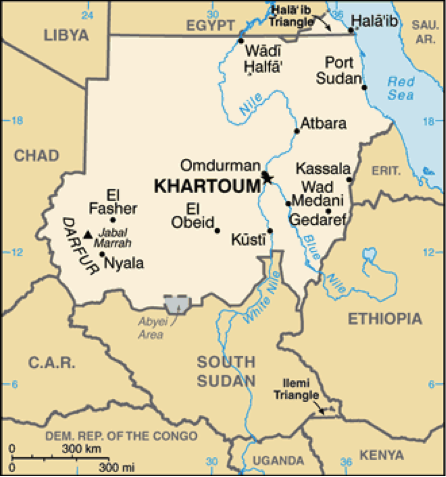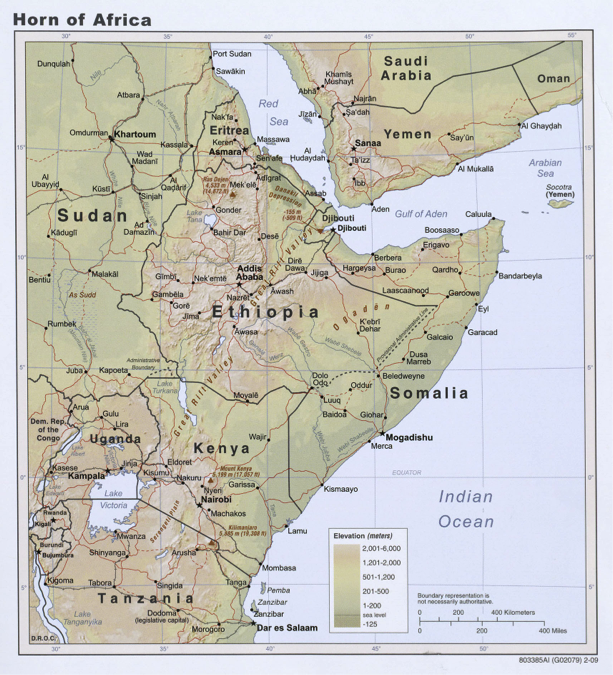The Nile River "Conflict"
There are many examples of water disputes involving cross-boundary uses of shared resources. For example, in Module 5, we discussed the damming of the Nile River in Egypt and the Nile River's importance to development and water supply in Egypt. The construction of the Aswan Dam, which was authorized by a Nile Waters Agreement of 1959, was of little immediate concern to countries in the source regions of the Nile (Figs. 1 and 2), but guaranteed water rights allocated by earlier agreements were. Egypt initially negotiated the Nile Waters Agreement of 1929 with, what was then, a number of East African colonies of Britain (British as signatories). Through this agreement, Egypt was assigned rights to 48 billion cubic meters/year (bcm/y), including all dry-season flow (mainly from the White Nile), and Sudan, just to Egypt's south, was initially apportioned 4 bcm/y. In addition, Egypt had the right to veto upriver water projects. A later treaty, the so-called 1959 Nile Waters Agreement between Egypt and Sudan, allocated 55.5 bcm/y to Egypt and 18.5 bcm/y to Sudan—the total allocation was nearly 90% of the estimated average annual Nile River flow (84 bcm/y, mostly from the Blue Nile)! This was accomplished prior to independence for the other countries within the watershed and failed to include the monarchy of Ethiopia in negotiations. Interestingly, at the time of the agreement, the White Nile was considered, in error, the source of most of Nile water. Seasonal summer monsoonal rains in the Ethiopian Highlands are the source of much of the Nile waters, through the Blue Nile.


Conflicts have arisen, particularly since Ethiopia embarked on dam building. In 2010, six of the nine upstream countries (Ethiopia, Kenya, Uganda, Rwanda, Burundi, and Tanzania) signed a Cooperative Framework Agreement seeking more water shares from the Nile. Egypt and Sudan rejected the agreement because it challenged their historic water allocations but to no avail. A major dam on the Blue Nile, the Grand Renaissance Dam, is under construction near the Ethiopia-Sudan border. As of May 2016, the dam was about 70% complete, with a target date of 2017 to begin producing power (it is worth noting, however, that the original target date was 2015 - political conflict and construction issues have slowed progress on the dam). Sudan and Egypt are, understandably, concerned about what will occur to Nile flows as the reservoir behind this huge dam fills, but Ethiopia is hoping that the water and power supplied by this structure will boost their economy and help other surrounding nations as well. Ethiopia's population in 1950 was about 18.1 million, but by 2014 it had grown to 96.5 million (87 people/km2). In 1950, Egypt had a population of 21.5 million, and in 2014 there are 83.4 million (83 people/km2). One can see that demand for water must be increasing (source: United Nations Department of Economic and Social Affairs), and that Ethiopia's growth has outstripped that of Egypt. However, Ethiopia has some other sources of water (estimated total river runoff at 122 bcm/y and additional large groundwater resources estimated at 6 bcm), whereas Egypt and Sudan must depend primarily on Nile water. However, Ethiopia has no storage capacity, hence the move to build a number of large dams. Will Egypt and Ethiopia go to war over Nile water? (see Analysis: Why Ethiopia and Egypt aren’t fighting a water war for a perspective ).
